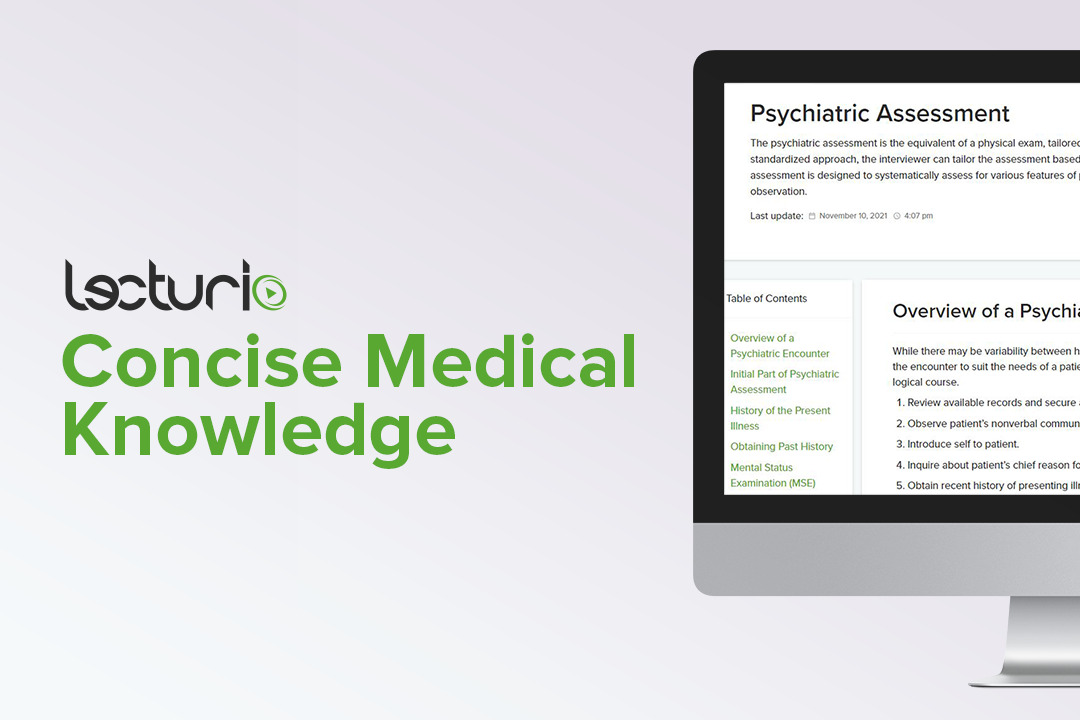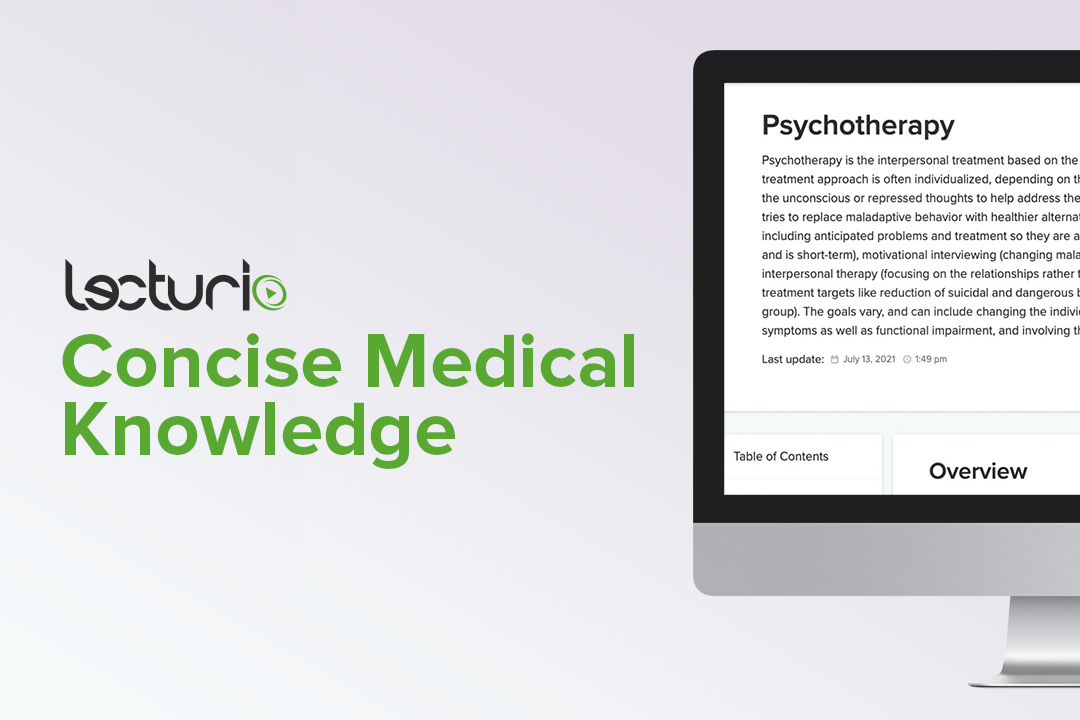Playlist
Show Playlist
Hide Playlist
Types of Psychotherapy
-
Slides TypesandApplication Psychiatry.pdf
-
Download Lecture Overview
00:01 Let's talk now about behavioral therapy. So, the goal is to reduce symptoms via relaxation, reinforcement, and graduated exposure to distressing stimuli. 00:13 This treats psychiatric disorders by helping patients change behaviors, sometimes substituting maladaptive behaviors with healthy alternatives that contribute to their symptoms. Some types of behavioral therapy are learning, conditioning, and deconditioning. Learning theory is where behaviors can be learned by conditioning and can similarly be unlearned by deconditioning. Let's consider a classic conditioning. 00:43 A stimulus can eventually evoke a conditioned response. 00:47 So, you may have heard of the classic example of Pavlov's dog. 00:51 This is where every time a bell rang, a dog was fed his dinner. 00:55 Therefore, over time, whenever the dog would hear a bell rang, he would start to salivate. 01:02 That's classic conditioning. Now, let's compare that to operant conditioning which is where behaviors can be learned when followed by positive or negative reinforcement. 01:14 Skinner's box is the example here. So, the example was that a rat was put in a cage and every time it pushed a lever, it would receive a treat. 01:23 So therefore, it learned to associate pushing the lever with a positive response. 01:29 Now, let's look at a deconditioning approach. Let's say a patient is afraid of dogs. 01:34 So, the way you would decondition this patient is to first, show her a picture of dogs and then maybe give her a stuffed animal. Maybe then she'll watch a movie with dogs in it and then she might actually go out and meet a dog, and pet it. That is systematic desensitization and here, the patient will perform relaxation techniques while being exposed to increasing doses of an anxiety provoking stimulus. Eventually, that patient may be made to imagine going to a dog park, this is called implosion and then eventually that patient will actually go to a dog park, and that is flooding. So, implosion involves intensive recollection or thought of an anxiety-producing situation or event in a patient's life. 02:24 Whereas flooding is when the individual is actually immersed in their feared situation. 02:30 Let's look at an approach to deconditioning. Let's take an alcoholic patient. 02:36 That patient can be given Antabuse which is aversive therapy. 02:40 So, basically when the patient drinks alcohol, they'll get violently sick. 02:44 Again, aversion therapy, a negative stimulus is repeatedly paired with specific behavior to create an unpleasant response and so, this is the classic example I shared with you of the alcoholic patient being given Antabuse to help them with their problem. 03:04 Now, let's consider a patient with schizophrenia. They're on a locked psychiatric unit and given a reward every time that patient takes a shower or takes care of their ADLs, that's called a token economy and the idea here is that rewards are given after specific behaviors to positively reinforce them. So, it's commonly used to encourage showering, shaving, and other ADLs on in-patient units. Now, let's consider a patient with a migraine. 03:31 She's encouraged to visualize the dilation of her arteries whenever experiencing pain. 03:38 This is biofeedback which is where physiological data like heart rate, blood pressure, etc. 03:45 are actually given to the patient during times of distress so then they can be coached to mentally imagine the problem going away and that helps to control the physiological state. 03:58 Let's talk about cognitive therapy. Cognitive behavioral therapy or CBT is a therapy that seeks to correct faulty assumptions and negative feelings that exacerbate psychopathology. 04:13 It's a manual driven therapy first described by Aaron Beck and very popular and very well studied. 04:20 It actually has proven efficacy with controlled research. The fundamentals of CBT include education, relaxation, coping skills training, stress management, and assertiveness training. 04:34 The best type of patients for CBT are highly motivated, they're self-observers, and they're real problem solvers. Now, interpersonal therapy. 04:44 This addresses relationships in the 'here and now' and it's also manual driven just like CBT. 04:52 Interpersonal therapy focuses on the individual's life in four problem areas, grief, interpersonal disputes, role transitions, and also interpersonal skills defects. 05:06 Now, let's talk about motivational interviewing. This is an approach to help patients change maladaptive behaviors via recognition of problematic behaviors and matching strategies to the patient's stage of readiness to change. Motivational interviewing really includes expressing empathy and it's all about meeting the patient where they're at right now and helping them to create an idea of what they want to see change. 05:37 There's a cycle of change that we think about when we are addressing issues with patients through motivational interviewing. So, let's take for example the chronic alcoholic and we're hoping to motivate them through stages of change. 05:51 Most people start at a pre-contemplated stage. Later, they'll become contemplative, then motivated, and often there's a relapse in their symptoms, and the cycle starts all over again. 06:03 So, it's an ever evolving cycle that patients kind of shift in and out of and our goal is to keep motivating them to moving towards the motivated stage of health. 06:12 The patients that respond best are in fact highly motivated, they're self-observers, again problem solvers, and they actually want to make a change. 06:22 Key elements in motivational interviewing are again, expressing empathy, identifying discrepancies to the patient between their problematic behavior and their actual personal values. Also, expecting the patient to resist change and accept it. 06:39 It's going to happen when you're using this kind of therapy but you're really trying to enhance your patient's sense of self-efficacy that they in fact are their own agent of positive change. 06:51 Dialectical behavioral therapy, this was actually developed by Marsha Linehan and it's a special treatment for borderline personality disorder. 07:01 It focuses on the main goals of reducing self-injurious behavior and also reducing the number of hospitalizations a patient might incur. So, there are four areas that DBT focuses on, teaching patients about mindfulness, interpersonal effectiveness, emotion regulation, and distress tolerance. Now, supportive psychotherapy, this is another approach that one can take, it's usually brief but has an active focus on helping the patient deal with a life crisis. 07:34 The therapist will offer advice, sympathy, and support while reinforcing the patient's strengths. 07:41 Group therapy, this is a therapeutic approach that incorporates discussion, sharing of feelings, and peer supports. 12 step programs such as Alcoholics Anonymous or AA are great examples of group therapies. Group therapy is especially useful in the treatment of not only substance abuse but also adjustment disorders and personality disorders, of note they can also help a lot in grief and bereavement, they can help a lot with major depression and anxiety. 08:14 Advantages of group therapy over individual therapy include the fact that the patient gets immediate feedback and from their peers, so it usually fosters a non-judgemental approach. 08:27 Patients can gain insight into their own condition by listening to others with a similar problem and then they feel less alone. If a therapist is present, there's an opportunity to observe interactions between others who may be eliciting a variety of transferences and then the therapist can intervene and point this out to the patients. 08:48 Family or marital therapy, this allows the entire family or unit to come together and better understand how psychopathology can affect the entire group and be aware of how tensions and conflicts may affect them and how each person responds a little bit differently. The goals are to actually reduce the conflict and help members understand each other better, help the unit cope with internally destructive forces. 09:17 In family therapy, the therapist will be attuned to boundaries between family members which sometimes can either be too rigid or maybe too permeable. 09:28 The therapist can point this out and show that triangles may actually result when two family members kind of form an alliance against the third. 09:37 That's another valuable tool that requires a therapist to see that objectively and point that out and then help the family make adjustments to accommodate for each other. 09:47 Marital therapy is especially useful in the treatment of conflicts involving sexual problems and communication problems, and the therapist can help each party to safely express their needs and desires and identify obstacles that are coming in the way of achieving all of this. 10:04 Usually, sessions are conjoint and often each person will have a separate therapist whom they're seeing one-on-one, we call this collaborative therapy. 10:15 So, that's a summary of some of the more common and important therapies. 10:21 You now are familiar with their names, a little bit about what they do, and you can apply this knowledge to your exam.
About the Lecture
The lecture Types of Psychotherapy by Helen Farrell, MD is from the course Psychiatric Assessment. It contains the following chapters:
- Behavioral Therapy
- Cognitive Therapy
- Interpersonal Therapy
- Dialectical Behavioral Therapy
- Supportive Psychotherapy
- Group Therapy
- Family Therapy/Marital Therapy
Included Quiz Questions
A rat in a cage receives a treat every time it pushes a lever. This is an example of which of the following?
- Operant conditioning
- Classic conditioning
- Flooding
- Classic deconditioning
- Systemic desensitization
Which of the following terms best describes "deconditioning involving intensive thought of anxiety-producing situations or events in a patient’s life"?
- Implosion
- Flooding
- Aversion
- Systemic desensitization
- Operant deconditioning
Which of the following best explains the concept of biofeedback?
- Physiological data are given to the patients as they try to mentally control physiological states.
- Rewards given after specific behaviors to positively reinforce them.
- A negative stimulus repeatedly paired with specific behavior to create an unpleasant response.
- Immersing an individual in their feared stimulus.
- Performing relaxation techniques while being exposed to increasing doses of an anxiety provoking stimulus.
Which type of behavioral therapy is specifically used for borderline personality disorder?
- Dialectical behavior therapy
- Cognitive-behavioral therapy
- Interpersonal therapy
- Motivational interviewing
- Supportive therapy
Customer reviews
5,0 of 5 stars
| 5 Stars |
|
5 |
| 4 Stars |
|
0 |
| 3 Stars |
|
0 |
| 2 Stars |
|
0 |
| 1 Star |
|
0 |





